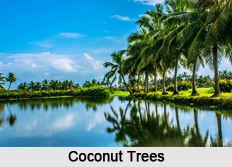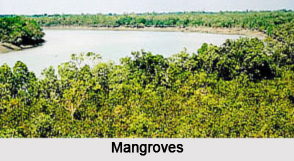 The Indian Subcontinent provides suitable conditions for the growth and development of various kinds of trees. Trees growing in the coastal areas of India are no exception in this regard. A few of these trees are described below.
The Indian Subcontinent provides suitable conditions for the growth and development of various kinds of trees. Trees growing in the coastal areas of India are no exception in this regard. A few of these trees are described below.
Coconut Trees
Coconut is cultivated mainly in the coastal tracts of Kerala, Tamil Nadu, Karnataka, Andhra Pradesh, Odisha, West Bengal, Puducherry, Maharashtra, Andaman and Nicobar Islands and Lakshadweep Islands of India. This tree is a large palm, which can attain a height of about 30 m. It has pinnate leaves. The coconut has three layers namely, exocarp, mesocarp and endocarp. The exocarp and mesocarp make up the "husk" of the coconut. The mesocarp is composed of a fiber called coir. The shell has three germination pores (micropyles) which are conspicuous on the outside surface post the removal of the husk. The weight of a full-sized coconut is about 1.44 kg (3.2 lb). This tree has a fibrous or adventitious root system. In this kind of system, there is abundance of thin roots that grows outward from the plant near the surface. Only a few of the roots penetrate deep into the soil for stability. Coconut palms produce roots from the base of the stem throughout their lives.
Mangroves
A mangrove is a shrub or small tree which finds suitable conditions to grow in coastal saline or brackish water. Mangrove forests occupy the deltas of the Ganges, Mahanadi, Krishna, Godavari and Kaveri rivers. These trees have broad, leathery and evergreen leaves. Mangrove forests comprise one of the most productive terrestrial eco systems. These salt tolerant trees are called halophytes. They have the capability to adapt to harsh coastal conditions and low oxygen (anoxic) conditions of waterlogged mud. A complex salt filtration system and complex root system helps them to cope with salt water immersion and wave action. Various kinds of saline conditions are tolerated by various types of mangroves like that in brackish water, in pure seawater (3 to 4%), water concentrated by evaporation and over twice the salinity of ocean seawater (up to 9%).
Casuarina
The Andhra Pradesh Forest Development Corporation (APFDC) and the Forest Department has taken up the initiative to motivate Vana Samrakshana Samitis to develop Casuarina plantation under the joint forest management. These plantations along the river and in the coastal areas are expected to check wind velocity reducing damage during natural calamities. More specifically, line planting in the coastal areas is expected to control the wind force and stabilizing the sand dunes.











